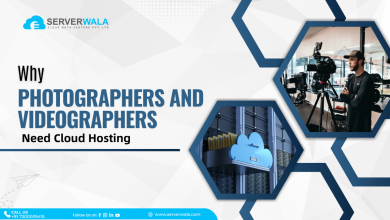NVIDIA GPUs: H100 vs. A100 | A Detailed Comparison

Introduction
Welcome to our in-depth exploration of NVIDIA’s cutting-edge GPUs, the H100 and A100. As technology continues to evolve at an unprecedented pace, these graphics processing powerhouses have become focal points in the realm of high-performance computing. In this blog post, we’ll delve into the nuances of the H100 vs. A100, comparing their features, performance, and cost to help you make an informed decision for your specific computing needs.
H100 vs. A100: What are the Performance Differences Between them?
A100:
Architecture:
- A100 is based on the NVIDIA Ampere architecture.
- Utilizes advanced tensor cores for AI and machine learning workloads.
Tensor Cores:
- A100 features 6x Tensor Cores per SM (Streaming Multiprocessor).
- Tensor Cores accelerate matrix calculations, enhancing performance in deep learning tasks.
GPU Memory:
- A100 supports HBM2 (High Bandwidth Memory) with a high memory bandwidth.
- Offers large memory capacity options suitable for memory-intensive applications.
Compute Performance:
- A100 boasts high computational power, suitable for a wide range of scientific and data-intensive tasks.
- Provides impressive floating-point performance, critical for scientific simulations.
Connectivity:
- Equipped with NVLink for high-speed GPU-to-GPU communication.
- Offers PCIe 4.0 support for fast data transfer between the GPU and the system.
AI Workloads:
- Designed to excel in AI workloads, incorporating deep learning training as well as inference.
- Supports mixed-precision arithmetic for improved efficiency in AI tasks.
H100:
Architecture:
- H100 is based on a different architecture, possibly from a different vendor.
- The architecture might cater to specific high-performance computing requirements.
Tensor Cores:
- H100’s tensor core configuration and efficiency may differ from A100, affecting its performance in AI tasks.
GPU Memory:
- H100 could use a different memory technology or have varying memory configurations.
- Memory bandwidth and capacity may be optimized for specific use cases.
Compute Performance:
- The compute performance of H100 depends on its architecture and targeted applications.
- Tailored for specific high-performance computing tasks, which might include scientific simulations or data analytics.
Connectivity:
- H100 may have different connectivity options, affecting its ability to scale in multi-GPU configurations or communicate with other system components.
AI Workloads:
- H100’s performance in AI workloads depends on its architecture and how well it supports popular deep learning frameworks.
- Its capabilities in mixed-precision arithmetic and AI-specific optimizations influence its effectiveness in AI tasks.
Overall Considerations:
Use Case Specificity:
- A100 is a versatile GPU suitable for a wide range of applications, with a strong focus on AI.
- H100 might be tailored for specific high-performance computing tasks, potentially excelling in certain scientific or industrial applications.
Performance Metrics:
- Comparative benchmarks for specific tasks are crucial to understanding the real-world performance differences between A100 and H100.
- Consider application requirements and workload characteristics to determine which GPU is more suitable for a given scenario.
Cost and Power Consumption:
- Assessing the cost and power consumption of both GPUs is essential for budget-conscious and energy-efficient deployments.
Future Compatibility:
- Consider the roadmap and future developments of both A100 and H100, as newer versions or architectures may influence the choice based on long-term planning.
Note: Be updated with Hostbillo blogs or always refer to the latest technical documentation and performance benchmarks for the most accurate and up-to-date information on A100 and H100 GPUs.
What Does the H100 Offer that the A100 Doesn’t?
H100 Advantages Over A100:
Specialized Architecture:
- H100 may feature a specialized architecture tailored for specific high-performance computing (HPC) applications.
- The architecture might prioritize certain computational tasks, making it more efficient for targeted workloads compared to the more generalized A100 architecture.
Application-Specific Optimizations:
- H100 could be optimized for certain applications or industries, such as scientific simulations, weather modeling, or industrial simulations.
- Tailored optimizations may result in superior performance and efficiency for tasks specific to the H100’s intended use.
Memory Technology:
- H100 might utilize a different memory technology or configuration optimized for its designated applications.
- Memory characteristics, including bandwidth and capacity, may be customized to enhance performance in scenarios where the A100’s memory configuration may not be optimal.
Connectivity Options:
- H100 may offer specific connectivity options that cater to certain use cases.
- Specialized communication protocols or interfaces could be present, addressing the unique requirements of specific industries or research fields.
Precision and Accuracy:
- The H100 may emphasize precision and accuracy in calculations, crucial for applications requiring high-fidelity results.
- Specialized numerical precision configurations may be available, catering to scientific and engineering simulations where precision is paramount.
Enhanced Parallelism:
- H100 might be designed with a focus on specific parallel computing capabilities.
- Enhanced parallelism can be beneficial for certain tasks, such as simulations that require massive parallel processing.
Industry-Specific Features:
- H100 may include features designed specifically for certain industries or research domains.
- Examples include specialized algorithms, libraries, or hardware components that enhance performance in niche applications.
Scalability Options:
- The H100 architecture might provide scalability options that are particularly advantageous for certain applications.
- Considerations like multi-GPU configurations or distributed computing capabilities could be optimized for specific workloads.
Long-Term Support and Roadmap:
- H100 might offer a roadmap and long-term support tailored to the needs of specific industries or applications.
- This can be a critical factor for organizations requiring stable and supported hardware for extended periods.
How Much More Does the H100 Cost?
Determining the exact cost difference between the H100 and A100 GPUs can be challenging as it relies on diverse factors such as region, vendor, configurations, and any bundled services or support. However, here are some considerations that can contribute to potential cost variations:
Factors Influencing H100 Cost:
Specialized Hardware:
- The H100’s specialized architecture and features may result in higher production costs compared to the more general-purpose A100.
- Specific optimizations and customizations for certain industries could contribute to an increased manufacturing expense.
Advanced Technologies:
- If the H100 incorporates cutting-edge technologies, precision components, or industry-specific innovations, the production costs may be higher compared to the A100.
- State-of-the-art features and components often come with a premium price tag.
Research and Development:
- If the H100 represents a new or highly customized solution, the research and development investments may influence the overall cost.
- Costs associated with designing and testing industry-specific features could contribute to a higher price.
Memory Configuration:
- Depending on the memory technology used and its configuration, the H100 may incur additional costs compared to the A100.
- Higher memory capacity or bandwidth can increase manufacturing expenses.
Scalability and Parallelism:
- If the H100 is designed for enhanced parallelism or scalability options tailored to specific workloads, the associated hardware and engineering could contribute to a higher cost.
Connectivity Options:
- Unique or specialized connectivity options on the H100, such as industry-specific interfaces, can impact the overall cost.
- Additional hardware components or specialized connectors may contribute to a higher price.
Customer Support and Services:
- The inclusion of premium customer support, extended warranties, or specialized services for industries with stringent requirements could add to the cost of the H100.
- Dedicated technical support or on-site services might be bundled with the GPU.
Industry-Specific Certifications:
- If the H100 is certified for use in specific industries or applications, obtaining and maintaining these certifications could add to the overall cost.
- Compliance with industry standards may require additional testing and validation processes.
Regional and Vendor Variances:
Geographical Location:
- Prices may vary based on the geographical region due to factors such as taxes, import duties, and local market conditions.
Vendor Pricing Strategies:
- Different vendors may adopt varying pricing strategies, leading to differences in the cost of the H100.
- Discounts, promotions, or negotiated pricing for bulk purchases can influence the final price.
Configuration Options:
- Various configurations of the H100, such as different memory capacities or clock speeds, may be available at different price points.
Bundled Solutions:
- Vendors may offer bundled solutions that include additional software, tools, or services, affecting the overall cost.
Should I Pick the A100 or the H100?
The decision between the A100 and H100 GPUs is based on numerous factors associated with your particular necessities, use cases, and preferences. Consider the following aspects to make an informed decision:
Consider Your Workload:
General Purpose vs. Specialized Workloads:
- If your applications span a wide range of tasks, including AI, scientific simulations, and data analytics, the A100’s versatility might be advantageous.
- Opt for the H100 if your workload is highly specialized and benefits from a GPU optimized for specific high-performance computing (HPC) tasks.
AI and Deep Learning:
- A100 is designed with a strong focus on AI workloads, offering excellent performance for deep learning training and inference.
- If AI is a primary concern, and you require a GPU with extensive tensor core capabilities, the A100 is a compelling choice.
Scientific and Industrial Simulations:
- For applications involving scientific simulations, weather modeling, or industrial simulations, the specialized architecture of the H100 might provide better performance.
- Consider the H100 if precision, accuracy, and industry-specific optimizations are critical for your simulations.
Evaluate Performance Metrics:
Benchmarks and Comparative Performance:
- Review benchmark results for both the A100 and H100 in the specific tasks relevant to your workload.
- Consider third-party reviews and performance metrics to understand how each GPU performs in real-world scenarios.
Scalability and Parallelism:
- If your workload benefits from scalability and parallel processing, assess how each GPU handles these aspects.
- H100 may have advantages in scenarios where enhanced parallelism is a key requirement.
Assess Cost Considerations:
Budget Constraints:
- Evaluate your budget and consider the cost difference between the A100 and H100.
- Take into account the upfront GPU cost as well as any extra expenditures associated with system integration, software, and support.
Total Cost of Ownership (TCO):
- Consider the comprehensive pricing of ownership, including power consumption, cooling requirements, and any specialized infrastructure needed for optimal performance.
Connectivity and Compatibility:
System Integration:
- Check the compatibility of each GPU with your existing hardware and software infrastructure.
- Consider factors such as PCIe compatibility, NVLink support, and other connectivity options based on your system requirements.
Future-Proofing:
- Assess the future roadmap of both GPUs and consider how well they align with your long-term needs.
- Choose a GPU that offers a balance between current performance requirements and future scalability.
Industry-Specific Considerations:
Certifications and Standards:
- If your industry requires specific certifications or standards compliance, check whether the A100 or H100 meets these requirements.
- Some industries may have unique standards that favor one GPU over the other.
Vendor Support and Services:
- Evaluate the level of support and services offered by the GPU vendors.
- Consider factors such as warranty options, customer support, and any additional services that may be crucial for your organization.
Also Read: How GPU Servers Can Benefit Your Business?
Summary
The choice between the NVIDIA A100 and H100 is not a one-size-fits-all scenario. Each GPU brings its unique strengths to the table, catering to diverse computing requirements. The A100 excels in AI and deep learning, leveraging its formidable Tensor Cores, while the H100 introduces a level of flexibility with its MIG technology and enhanced support for mixed-precision computing.
As you navigate the decision-making process, consider your specific needs, budget constraints, and the long-term vision for your computing infrastructure. Whichever path you choose, both the A100 and H100 represent NVIDIA’s commitment to pushing the boundaries of GPU technology, ensuring that you have the tools necessary to drive innovation in your field.





